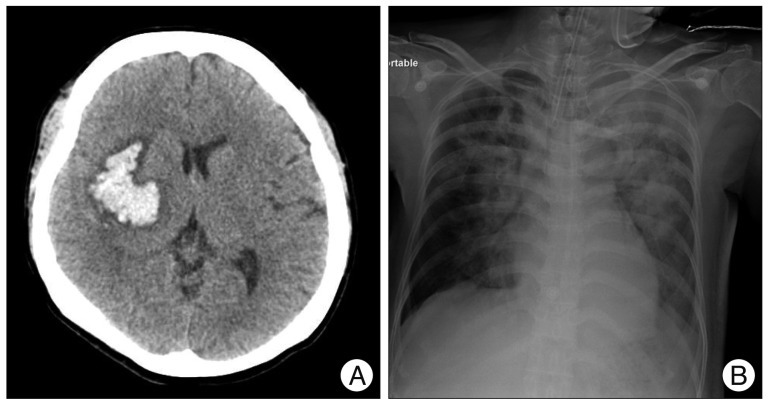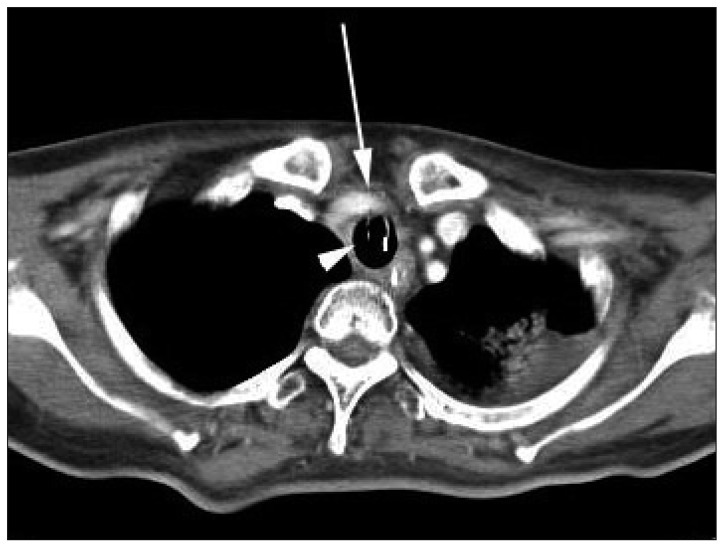J Korean Neurosurg Soc.
2012 Dec;52(6):547-550. 10.3340/jkns.2012.52.6.547.
Successful Treatment of Tracheoinnominate Artery Fistula Following Tracheostomy in a Patient with Cerebrovascular Disease
- Affiliations
-
- 1Department of Neurosurgery, Gospel Hospital, Kosin University College of Medicine, Busan, Korea. ysparkns@kosinmed.or.kr
- 2Department of Thoracic and Cardiovascular Surgery, Gospel Hospital, Kosin University College of Medicine, Busan, Korea.
- KMID: 1426265
- DOI: http://doi.org/10.3340/jkns.2012.52.6.547
Abstract
- Tracheoinnominate artery fistula is a critical complication of tracheostomy. The most important factors influencing patient outcome are prompt diagnosis, immediate control of bleeding with a patent airway, and emergency operation with or without interruption of the innominate artery. Here, we report a case of tracheoinnominate artery fistula in a 40-year-old woman with cerebrovascular accident who was successfully managed with an aorta-axillary artery bypass.
Figure
Cited by 1 articles
-
Biting of the Tongue in a Patient with a Tracheostomy during Surgery in the Supine Position
Myung-Soo Jang, Jong-Man Kang
J Korean Neurosurg Soc. 2014;56(3):284-285. doi: 10.3340/jkns.2014.56.3.284.
Reference
-
1. AbuRahma AF, Robinson PA, Khan MZ, Khan JH, Boland JP. Brachiocephalic revascularization : a comparison between carotid-subclavian artery bypass and axilloaxillary artery bypass. Surgery. 1992; 112:84–91. PMID: 1621229.2. Allan JS, Wright CD. Tracheoinnominate fistula : diagnosis and management. Chest Surg Clin N Am. 2003; 13:331–341. PMID: 12755317.3. Black MD, Shamji FM, Todd TR. Trachea-innominate artery fistula and concomitant critical cerebrovascular disease. Ann Thorac Surg. 1996; 62:286–288. PMID: 8678666.
Article4. Gasparri MG, Nicolosi AC, Almassi GH. A novel approach to the management of tracheoinnominate artery fistula. Ann Thorac Surg. 2004; 77:1424–1426. PMID: 15063280.
Article5. Gelman JJ, Aro M, Weiss SM. Tracheo-innominate artery fistula. J Am Coll Surg. 1994; 179:626–634. PMID: 7952471.6. Hamaguchi S, Nakajima Y. Two cases of tracheoinnominate artery fistula following tracheostomy treated successfully by endovascular embolization of the innominate artery. J Vasc Surg. 2012; 55:545–547. PMID: 21958569.
Article7. Jones JW, Reynolds M, Hewitt RL, Drapanas T. Tracheo-innominate artery erosion : successful surgical management of a devastating complication. Ann Surg. 1976; 184:194–204. PMID: 782389.8. Sashida Y, Arashiro K. Successful management of tracheoinnominate artery fistula using a split pectoralis muscle flap with anatomical reconstruction by a synthetic graft. Scand J Plast Reconstr Surg Hand Surg. 2010; 44:175–177. PMID: 20158425.
Article9. Scalise P, Prunk SR, Healy D, Votto J. The incidence of tracheoarterial fistula in patients with chronic tracheostomy tubes : a retrospective study of 544 patients in a long-term care facility. Chest. 2005; 128:3906–3909. PMID: 16354862.
Article10. Sung JH, Kim IS, Yang SH, Hong JT, Son BC, Lee SW. Is computerized tomography angiographic surveillance valuable for prevention of tracheoinnominate artery fistula, a life-threatening complication after tracheostomy? J Korean Neurosurg Soc. 2011; 49:107–111. PMID: 21519499.
Article11. Takasaki K, Enatsu K, Nakayama M, Uchida T, Takahashi H. A case with tracheo-innominate artery fistula. Successful management of endovascular embolization of innominate artery. Auris Nasus Larynx. 2005; 32:195–198. PMID: 15917179.
- Full Text Links
- Actions
-
Cited
- CITED
-
- Close
- Share
- Similar articles
-
- Tracheoinnominate Artery Fistula: A Case Report
- Endovascular stenting of tracheoinnominate fistula after tracheostomy in a 14-year-old boy
- Tracheoplasty with using the Costal Cartilage, Including the Perichondrium, for Treating a Tracheoinnominate Artery Fistula: Surgical experience of one case
- Is Computerized Tomography Angiographic Surveillance Valuable for Prevention of Tracheoinnominate Artery Fistula, a Life-Threatening Complication after Tracheostomy?
- Tracheo-Innominate Artery Fistula: a case report





